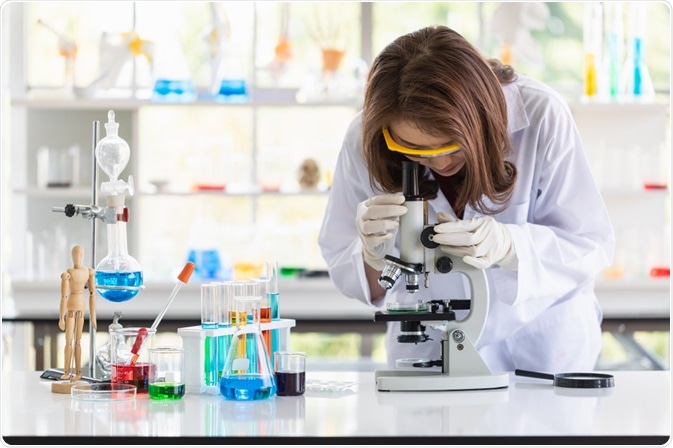There is a continuous and growing demand for new and existing organic and inorganic chemical products. Chemical products encompass things like pharmaceuticals, agrochemicals, polymers, and other functional materials, flavors/fragrances, food supplements, cosmetics, fuels, cleaning products, personal care products, and many more products.

Chemistry Experiment. Image Credit: Bangkok Click Studio/Shutterstock.com
The identification, extraction, and synthesis of new products require chemists and biochemists to continually re-design experiments for specified outcomes. Experimental procedures are often required to carry out quality control and to identify why unwanted bi-products are produced in existing manufacturing processes. Experiments take up valuable time and resources and seldom give instantaneous results.
Research and industrial chemists, biochemists, and chemical engineers are often called upon to devise experiments to optimize chemical processes to give greater yields and greater product purity. This requires scientists and engineers to regularly design and redesign experiments. As the chemistry involved becomes more complex so does the design of the experiment and Experimental Design in Chemistry is almost a science on its own.
Traditional Experiment Design
Traditionally the process of experimental design may have started with a hypothesis or a defined research target. The chemist would then make a prediction and work out a way to test the prediction. To design the experiment the chemist would:-
- Identify the variables
- Arrange the conditions
- Decide on the variables and what would variable could be manipulated
- Carry out a Risk assessment
- Experiment and make observations
- Change one or more variable and repeat
The team would then repeat the process of making observations and adjustments until the required solution has been achieved or eliminated. This process was often run on an OVAT (One Variable A Time) basis which is a simple but laborious and effective way of determining the results.
Design Of Experiments
Design of Experiments is a phrase introduced by Statistician and Geneticist Ronald Fisher in 1935. Using Design of Experiments (DOE) the relationship between the factors can be varied and the relationship between the various factors can be systematically investigated using statistical analysis. This process increases the manpower required as you now need at least one mathematician and probably a statistician when designing an experiment in addition to a chemist.
Using the enhanced team and specialist software and computing power the parameters required can be designed within an hour or two rather than many days or weeks offsetting the increased personnel costs.
Artificial Intelligence (AI) or machine learning can also help as it can be used to predict molecule properties, molecular structure, and reaction outcomes as well as optimum experimental conditions. The use of AI will potentially add an “it” specialist to the team but will reduce the time required to design the experiment. Using computers allows many iterations of any design to be carried out very quickly.
AI can also be used for “retrosynthesis”. This is the process of working backward from a target molecule to a commercially available material that can be used in the manufacture of the target molecule. Performing this manually would be time-consuming but ai makes the process quick so that the design of the experiment can begin in a short time.
Control and Monitoring
The ability to identify and isolate products is an area that is continually improving and developing. The use of chromatography, mass spectrometry, spectrography, chromatography, microscopy, and many other sophisticated techniques mean that more and complicated products can be identified.
The process of identifying them can be more and more complicated but the development of instrument and control technology opens up the opportunity to design more sophisticated experiments. Digital data capture allows for more data to be captured more accurately which allows the scientist designing the experiment to acquire and analyze more data more quickly and reach more precise conclusions.
New equipment and techniques also allow for a smaller and smaller sample to be analyzed down to picoliters or one trillionth of a liter of sample. Improved manufacturing techniques allow for very precisely built equipment operating under harsh conditions to be manufactured increasing the scope of experimental designs. Enhanced control and monitoring capability allows for a greater range of experimental conditions to be considered but also allows closer control of conditions within the experiment.
Chemometrics
In 1971 Svante Wold invented the term Chemometrics which is the science of extracting data from chemical systems using applied mathematics and computer science data. There are now at least three peer-reviewed journals published about chemometrics.
Chemometrics is a multidisciplinary approach to experimental design which allows the chemist to design experiments that get closer to the solution before even starting the experimental process.
Software
There are dozens of open source, free, and proprietory software packages listed on the internet for statistical analysis and chemical reaction prediction. Many of the software suppliers will have existing templates as well as the facility to custom design experiments to fit any particular set of experimental conditions or a specified outcome.
Conclusions
Experimental design in chemistry now opens new horizons for chemists to imagine and produce all kinds of new products. The use of modern techniques and technologies not only allows an experimental chemist to design more sophisticated experiments but also allows the chemist to start from a position where many of the unproductive options have been eliminated and a likely outcome has been predicted. DOE can also be used to optimize and improve existing chemical processes for the benefit of all concerned. The science of designing experiments will continue to develop and offer opportunities in the future.
Further Reading
Last Updated: May 17, 2021